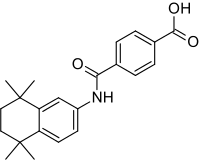Tamibarotene
 | |
| Names | |
|---|---|
| IUPAC name
4-[(1,1,4,4-tetramethyltetralin-6-yl)carbamoyl]benzoic acid | |
| Identifiers | |
| 94497-51-5 | |
| 3D model (Jmol) | Interactive image |
| 3564473 | |
| ChEBI | CHEBI:32181 |
| ChEMBL | ChEMBL25202 |
| ChemSpider | 97231 |
| DrugBank | DB04942 |
| 2648 | |
| PubChem | 108143 |
| UNII | 08V52GZ3H9 |
| |
| |
| Properties | |
| C22H25NO3 | |
| Molar mass | 351.45 g·mol−1 |
| Except where otherwise noted, data are given for materials in their standard state (at 25 °C [77 °F], 100 kPa). | |
| Infobox references | |
Tamibarotene (brand name: Amnolake), also called retinobenzoic acid, is orally active, synthetic retinoid, developed to overcome all-trans retinoic acid (ATRA) resistance, with potential antineoplastic activity against acute promyelocytic leukaemia (APL) .[1] It is currently marketed only in Japan and early trials have demonstrated that it tends to be better tolerated than ATRA.[2] It has also been investigated as a possible treatment for Alzheimer's disease, multiple myeloma and Crohn's disease.[2][3]
Synthesis
The tetralin-based compound tamibarotene (7) has been tested as an agent for treating leukaemias.

Reaction of the diol (1) with hydrogen chloride affords the corresponding dichloro derivative (2). Aluminum chloride mediated Friedel–Crafts alkylation of acetanilide with the dichloride affords the tetralin (3). Basic hydrolysis leads to the primary amine (4). Acylation of the primary amino group with the half acid chloride half ester from terephthalic acid (5) leads to the amide (6). Basic hydrolysis of the ester grouping then affords (7).[4]
References
- ↑ "Tamibarotene: AM 80, retinobenzoic acid, Tamibaro". Drugs in R&D. 5 (6): 359–62. 2004. doi:10.2165/00126839-200405060-00010. PMID 15563242.
- 1 2 Miwako, I; Kagechika, H (August 2007). "Tamibarotene". Drugs Today (Barc). 43 (8): 563–568. doi:10.1358/dot.2007.43.8.1072615. PMID 17925887.
- ↑ Fukasawa, H; Nakagomi, M; Yamagata, N; Katsuki, H; Kawahara, K; Kitaoka, K; Miki, T; Shudo, K (2012). "Tamibarotene: a candidate retinoid drug for Alzheimer's disease" (PDF). Biological & Pharmaceutical Bulletin. 35 (8): 1206–1212. doi:10.1248/bpb.b12-00314. PMID 22863914.
- ↑ Y. Hamada, I. Yamada, M. Uenaka, T. Sakata, U.S. Patent 5,214,202 (1993).